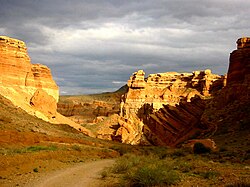Sharyn Canyon
| Sharyn Canyon | |
|---|---|
| Charyn Canyon | |

Sharyn Canyon, view down to Valley of Castles
|
|
| Location in Kazakhstan | |
| Location | Almaty, Kazakhstan |
| Long-axis length | 80 kilometres (50 mi) |
| Geography | |
| Coordinates | 43°21′29″N 79°05′33″E / 43.3581°N 79.0925°ECoordinates: 43°21′29″N 79°05′33″E / 43.3581°N 79.0925°E |
| Watercourses | Sharyn River |
Sharyn Canyon (also known as Charyn Canyon) is a canyon on the Sharyn River in Kazakhstan, 200 kilometres (120 mi) east of Almaty, close to the Chinese border. The canyon is 80 or 90 kilometres (50 or 56 mi) in length. It is within the Sharyn River valley and is part of the Sharyn National Park, which was established on 23 February 2004, and is located within the territory of the Uygur District, Raiymbek District and Enbekshikazakh District of the Almaty Province. Over several millennia of weathering action, the canyon has gained colorful formations of varying shapes and sizes. Though it is much smaller than the Grand Canyon, it has been described as being equally impressive.
One part of the canyon is known as Valley of Castles (Dolina Zamkov) for its unusual rock formations, and its length is 3 kilometres (1.9 mi) with a depth of 100 metres (330 ft).
Some scholars think that the name of the river is derived from the Uyghur word 'Sharyn' meaning "ash tree". There is also another interpretation that it is a derivative of the Turkic root word 'Char', which means a "precipice". Both these interpretations fit the site conditions where the terrain is precipitous, and ash trees are found.
The canyon formation is along the banks of the fast flowing Charyn River in a northern flow stretch of about 80 kilometres (50 mi) (90 kilometres (56 mi) is also stated) which is a tributary of the Ile River; the river has a total length of 393 kilometres (244 mi). The river rises from the Tian Shan Mountains (meaning: "Heavenly Mountains",) that is spread over the arid semi-desert to the east of Almaty. In parts, it attains a depth of 150 to 300 metres (490 to 980 ft). The geological formation of the canyon is of sedimentary red sandstone which have been subject to the "atmogenic process" (defined in Websters dictionary as "atmospheric origin by condensation, wind action, or deposition from volcanic vapors") of water and wind erosion resulting in "weird and colourful formations" in the form of sculptures.
...
Wikipedia

